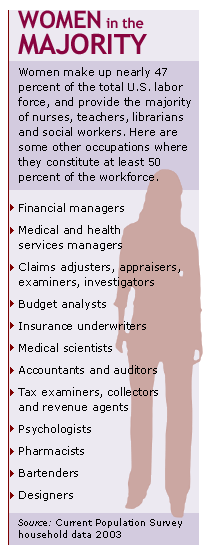NEW YORK (CNN/Money) – This year, for the first time in the history of Harvard University, the number of women offered admission to the incoming undergraduate freshman class outpaced the number of men.
That's just one indication of how far women have come in their quest to achieve educational and professional parity with men.
Women now earn more associate's, bachelor's and master's degrees than their male counterparts. In the academic year 2001-02, 57 percent of bachelor's degrees and 59 percent of master's degrees were awarded to women, according to data from the National Center for Education Statistics.
Women also earned nearly half of the Ph.D.s (46.3 percent) as well as first professional degrees (47.3 percent), which include medical, law and dental degrees.
In fact, women's presence is growing in a number of arenas that traditionally have been associated with men.
Counting the number crunchers
Accounting is a good example of a field where women have been reaching the majority both educationally and professionally.

According to the American Institute of Certified Public Accountants, 57 percent of undergraduate degrees in accounting were awarded to women in 2002.
Today, women account for roughly 59 percent of accountants, up from about 39 percent in 1983, according to data from the federal government's Current Population Survey.
Accounting giant KPMG is recruiting accordingly. In 2003, 52.3 percent of KPMG's hires from college campuses were women and overall 48 percent of its new hires for its accounting and tax professionals staff were women.
That swell in the ranks isn't visible in the boardroom yet. But the numbers are improving.
Only 13 percent of KPMG's U.S. partners are women, but that's double what it was in 1998. And among the partners to be named this year, 22 percent are women, according to KPMG.
More women doctors on tap
In the field of medicine, women are also continuing to make large strides. Even though they only accounted for 25.2 percent of all physicians in 2002, that's up from 17 percent in 1990.
And given their growing numbers in medical school and graduate training programs, it's very possible women will make up roughly 45 percent of all physicians by 2025, according to Edward Salsberg, director of workforce studies at the Association of American Medical Colleges (AAMC).
In the 2002-03 year, women accounted for 45 percent of all medical school graduates. And this year, for the first time, women made up the majority of applicants to medical school, according to the AAMC.
Among the specialties, women in 2002 made up the majority of residents in pediatrics, family practice, obstetrics and gynecology, psychiatry and dermatology, according to the Journal of the American Medical Association.
Women lawyers see small drop
The picture in law is not quite as bright. Women account for roughly 28 percent of all lawyers, according to CPS data. But that's down from the 29 percent reported in 2002.
Also slightly down is the number of women enrolling in law schools. For a few years the percentage hovered around 49 percent, but for the 2003-04 year, that percentage slipped to 48 percent, according the American Bar Association.
Nevertheless, women accounted for 49 percent of summer associates in 2003, according to research from the National Association of Law Placement. And women earned 49 percent of the JDs awarded last year.
At the staff level, NALP found women attorneys account for 43 percent of associate or staff/senior attorney positions. But in terms of making partner, women account for only 16.8 percent of partners at law firms nationwide. Even though that represents a small increase from 2002, relative to total headcounts at the firms, women remain underrepresented at the partner level.
Businesswomen make big strides
In business, women's representation is stronger than ever, but the number of women at the top is still not proportional to their ranks.
They account for 50.5 percent of managerial and specialty positions, according the CPS. But among Fortune 500 companies, women only represent 15.7 percent of corporate officers, 13.6 percent of board directors, 8 percent of those with the highest titles and 5.2 percent of the highest earners, according to the research firm Catalyst.
| RELATED ARTICLES
|

|
|
|
|
And among Fortune 500 CEOs? Only 1.6 percent – a total of eight -- are women.
Among privately owned businesses, more women than ever are at the helm. Nearly half (46 percent) of all privately held U.S. businesses are majority owned by women, according the Center for Women's Business Research.
On the earnings front
Even though there still exists a significant wage gap nationally between women and men in the labor force, an analysis of Current Population survey data by the Employment Policy Foundation, a public policy research group, found that the proportion of women earning six figures tripled between 1991 and 2001.
The EPF found that in 2001, one in every 48 women working full-time earned over $100,000. That's up from one in 143 in 1991.
The number of women earning over $60,000 almost tripled during the same period.
The numbers of men earning more than $60,000 and more than $100,000 also rose, but at much slower rates.
At the same time, the number of women earning less than $20,000 dropped by one-fifth.

|

